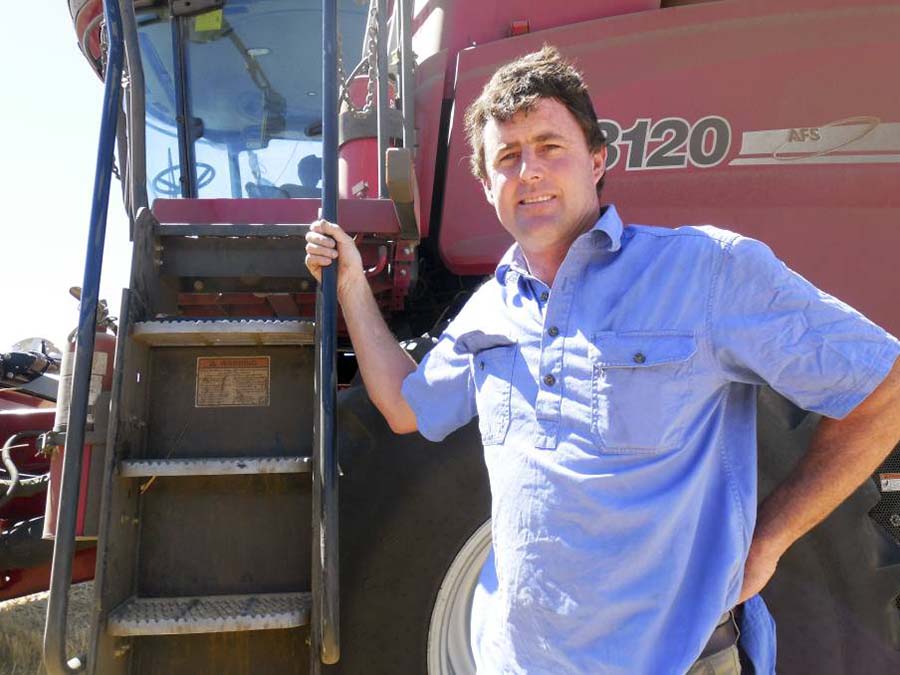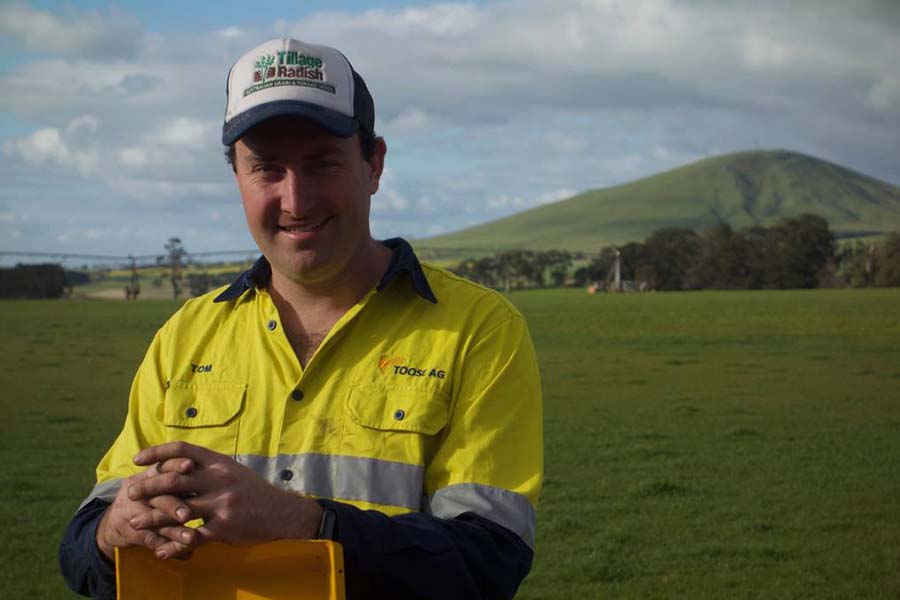Simple adjustments to the settings and set-up of a harvester could save millions of dollars in lost grain every harvest.
But first these losses must be accurately measured, according to Planfarm consultant Peter Newman.
A 2018 GRDC-invested project managed by Mr Newman, who is based in the northern agricultural region of Western Australia, has calculated that 150 kilograms per hectare, or $90 million of canola seed, is thrown from the back of harvesters on to the ground in Western Australia alone.
Based on the data from this WA extension project, researchers estimate $191 million of canola is lost nationally every year.
While global industry standards suggest an acceptable level for cereal loss is about one per cent of grain yield, translating to 20kg/ha for a two tonne per hectare wheat crop, feedback from WA growers suggests a loss of about three per cent, particularly for a canola crop, is more practical.
This equates to 45kg/ha for a 1.5t/ha canola crop.

Planfarm consultant Peter Newman says many growers do not realise how much grain they are losing from the back of harvesters. Photo: GRDC
Mr Newman says given the high value of a canola crop, this 45kg/ha loss, worth an estimated $22.50, is still significant at approximately four times the cost of any cereal loss.
As part of the research project, harvest drop trays were trialled by 10 growers across WA's grainbelt, and the results were surprising. Mr Newman says losses in the trial were significantly higher than the acceptable rate of 45kg/ha in a 1.5t/ha crop.
"I don't think many of the growers involved realised how much grain they were losing from the back of the harvester," Mr Newman says.
"The message from this project is to measure, change and measure again."
Mr Newman says there is no single recipe for harvester set-up to resolve high rates of harvest grain losses and each machine will respond differently in different crops and situations.
"For example, during this project, on one particular day we were in a 5t/ha wheat crop, with initial loss measurements at around 70kg/ha. When the sea breeze came in, losses went up to 250kg/ha within the space of just 15 minutes," he says.
Canola crops are particularly vulnerable to grain losses given the size of the grain and the large amount of biomass in the crop. But Mr Newman says cereal crops will also benefit from regular measuring and machine adjustments. He says there are now several measuring products on the market, all of which have been trialled by growers across the country.
Grower experience - WA
Darren and Jayme Yewers - Morawa, Western Australia
Enterprise: Mixed farming
Crops: Wheat, canola, field peas, lupins and chickpeas
Annual rainfall: 330 millimetres
Soil pH: 6.5
Soil types: Heavy red country, clay, some yellow sand.
Morawa grower Darren Yewers says a few simple adjustments to his harvester added $58,000 to his 2018 balance sheet from his canola crop alone.
As part of the GRDC project, Darren trialled the ScherGain Solution System drop tray. He estimates he was losing 286kg/ha of canola out of the back of the harvester, equating to about $157/ha.
It took several adjustments, including harvester speed, fan speed and sieve height, to settle on a fan speed of 750rpm, and sieve heights of 13mm (top sieve) and 4mm (bottom sieve), giving him the best loss rate of 72kg/ha, equating to $40/ha.
Darren tested out the drop tray on a bumper canola crop which averaged 2.1t/ha across 500ha.
"Canola was the first crop I trialled this on, simply because it's such a high-value crop and also because the grain is very small and loss rates are so high," he says.
The Yewers' business relies on Roundup Ready® Canola to play a role in cleaning up paddocks for ryegrass, so canola will continue to be part of the rotation for many years to come.
Because it is a high-value crop in a medium-low rainfall region, Darren says he can't afford to lose a large percentage of canola out of the back of the header.
His next drop tray trial will be on cereals, to see how he can adjust his machine to keep as much wheat in the bin as possible.
Darren has played around with home-made drop trays in the past but says it's almost impossible to achieve accurate readings without the ability to drop the tray remotely, using electromagnets that fix the tray on to the underside of the machine.
"But it did give us a sense that we needed to do something to minimise what was coming out of the back of the header and on to the paddock floor," he says.
While Darren admits that measuring the losses took time during a busy harvest, sorting the seed from the admixture and chaff, he believes it was worth the investment for the savings achieved.
Since the 2019 season hasn't been as kind in the Morawa region as 2018, Darren says canola crops will be lucky to average 1t/ha, meaning a new series of measurements will need to be taken and, more than likely, different adjustments made to the harvester.
"We now understand that we have to measure each different crop, each year, more than once, to ensure the machine is responding to each individual situation," he says.
Grower experience - WA
John and Emma Scotney - Badgingarra, Western Australia
Crops: Canola, wheat and barley
Annual rainfall: 450mm
Soil pH: 5.8
Soil type: gravels
After numerous adjustments to various components in the harvester, it was a simple reduction in harvesting speed that saved Badgingarra, WA, grower John Scotney more than $65,000 in canola losses last season.
John trialled the Bushel Plus Multi Calibration System as part of the GRDC research project and, after seeing how much canola he was losing from the back of the harvester, he adjusted the feeder house chain tension, the rear of the main sieve, the rotor speed and the fan air speed.

Badgingarra grower John Scotney. Photo: Cox Inall
But after spending several hours on the harvester with Bushel Plus founder Marcel Kringe, John says the best result came from slowing down his harvesting speed.
He says the harvester simply couldn't cope with the large amount of biomass from his 2.5t/ha swathed canola crop.
By slowing the machine from 20t/hour to 15t/hour, John reduced losses from 180kg/ha to 80kg/ha, with estimated savings of $66,000 across his 1200ha canola crop.
"We were roughly aware of what we were throwing out the back of the header, but we hadn't ever really quantified it before, so this was a very interesting process and it was good to see the reduction in these losses after we changed our header speed," he says.
Like many other growers, John had attempted to measure his losses using a home-made tray that was placed in the paddock, driven over by the harvester.
According to John, it was the simplicity of the electromagnetic drop tray and air separator system that encouraged him to move away from his home-made measuring system.
"The air separator that comes with this system is very simple, separating the chaff and admixture from the seed using an air blower bucket," he says.
John has been through various harvester brands in an attempt to achieve the lowest losses possible, but now agrees that regular measuring, and a trial-and-error approach to adjusting a range of machine functions, is the best way to minimise the losses.
He says he is hoping to use the drop tray system again this coming harvest to measure losses in all his crops to maximise returns.
Different crops across his property can vary greatly in density and biomass, meaning the harvester may need new adjustments each time he begins a new paddock.
"There doesn't seem to be a one-size-fits all approach to reducing these high crop losses, so that means measuring losses in each different crop, on a regular basis, and constantly making changes on your machine to get that loss percentage as low as possible."
Grower experience - Victoria
Tom Toose - Smeaton, Victoria
Enterprise: Mixed farming
Crops: Wheat, canola, faba beans, linseed and oaten hay
Annual rainfall: 550mm
Soil pH: 5.0 to 5.5
Soil types: volcanic reds to heavy clays
Relying on seasonal labourers, alongside permanent staff, to drive the harvester means Smeaton grower Tom Toose has to be vigilant in measuring harvest losses and constantly making small adjustments to his harvester to reduce grain losses.
Tom says he has been measuring harvest losses for many years with a home-made system designed using an old chemical drum and a long stick - but he knew his measuring system had limited scientific rigour.
He says even though his harvester monitors were showing very little grain losses, he could see, even using his home-made system, that he was losing quite a lot of grain.
Last harvest, Tom purchased the Australian-made Ag Gear Harvest Calibration Loss Tray, allowing him to more accurately measure the losses on all his crops.
 Smeaton grower Tom Toose with an Ag Gear Harvest Calibration Loss Tray. Photo: Cox Inall
Smeaton grower Tom Toose with an Ag Gear Harvest Calibration Loss Tray. Photo: Cox Inall
He says the canola losses he measured using the new system were even greater than he had anticipated.
"We definitely noticed how much we were losing out the back of the header in our canola crops, and while I haven't yet quantified what these losses were, visually it was quite obvious that we needed to change some settings on the machine to reduce this grain loss," he says.
By slowing down the rotor speed and the fan speed, Tom was able to see a significant reduction in grain losses during the measuring process.
Tom says a measuring system is particularly important for his business, since he uses a contractor who has a different, smaller harvesting machine as well as running his own harvester.
The electro-permanent magnets, which allow for extended periods of operation, are activated using a remote control, allow for ease of use and ensure safety is maintained.
"We will have to measure constantly throughout the harvest period, potentially up to three times a day, to make sure the settings on each different machine are fine-tuned to reduce these losses," Tom says.
He believes the initial financial outlay for a harvest loss measuring tray will be easy to recoup in savings and says he would recommend this approach to other growers.
Grower experience - NSW
Scott and Jill Vaessen - Tabbita, New South Wales
Enterprise: Mixed farming
Crops: Wheat, barley, canola, field peas, vetch and oats
Annual rainfall: 380 mm
Soil pH: 5.5 to 6.5
Soil types: sandy loam to red brown earth
While it is critical to reduce harvest losses, maximising the harvest return is even more important when it comes to the balance sheet.
For Tabbita grower Scott Vaessen, calculating the cost to his harvesting process when reducing grain losses was an essential part of fine-tuning his system.
Scott trialled the Harvest Calc app, which aims to find the 'sweet spot' between grain loss levels and harvest efficiencies.
"There is no point trying to get grain losses down to nothing if it's going to add significant costs on to your harvest - you have to find that balance to make it all economically viable," Scott says.
The app allows the grower to input grain loss percentages, calculating them as a percentage of total yield, kilograms per hectare or dollars per hectare figure.

Tabbita grower Scott Vaessen. Photo: Cox Inall
The app then calculates the net harvesting cost/tonne or cost/ha.
Scott has a chaff deck which allows him to regularly check on the chaff component of the header output.
He says he will measure his losses and use the app every couple of days during harvest to ensure he is as close to maximum harvest efficiency as possible.
Throughout last harvest, Scott adjusted settings of concave clearance, the fan speed and the rotor speed to better manage his grain losses.
He has also tested harvesting speed to ascertain the best speed in each different crop.
"I will measure and then input the numbers each time I start harvesting a new crop, since the seed size and circumstances are entirely different for each crop type, and then I will redo this every few days, or when the monitor shows me that something isn't quite right," he says.
For Scott, Harvest Calc is just another tool helping him to safeguard against leaving his profits in the paddock.
"If you are losing $20 to $25 in grain losses, it doesn't take long for this to add up and erode those profits," he says.
More information: Ag Gear Drop Tray, Bushel Plus Multi Calibration System, ScherGain Solution System and GRDC Harvest Loss Calculator.

























































